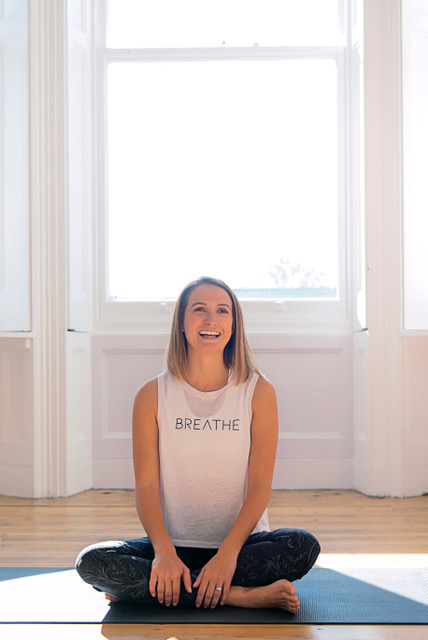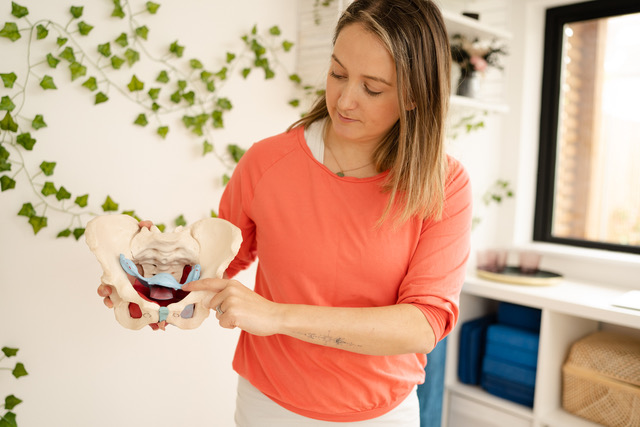Pelvic floor dysfunction after childbirth or menopause and how to reclaim your power
By Grace Lillywhite
It’s time pelvic floor health stopped being a taboo subject.
In the UK, over 60% of women have at least one symptom of poor pelvic floor health. Yet 69% haven’t spoken to anyone in the NHS about it. (Source)
That has to change.
We live in a culture where you can buy wall art that says, “Sometimes I laugh so hard, tears run down my legs.” It might sound funny, but it normalises dysfunction and for many women, leaking is far from funny. It’s deeply embarrassing and isolating. It can have a real negative impact on quality of life. In fact, 21% don’t seek help because they’re too embarrassed.
Pelvic floor dysfunction (PFD) is common, yes. But that doesn’t mean it’s normal or that you have to live with it.
Why Kegels Aren’t the Full Story
When women experience leaking, pelvic heaviness, or even back pain, the first stop is usually their GP. In an ideal world, that would lead to a referral to a women’s health physio who can properly assess what’s happening. But too often, women are dismissed. Told it’s “just part of motherhood” or “part of getting older.” They’re told to do their Kegels and sent on their way.
Here’s the problem:
Kegels aren’t always the solution. In fact, they’re not always helpful.
Squeezing your pelvic floor repeatedly is like trying to build stronger arms by flexing your biceps in mid-air, it’s not how muscles build long-term strength. The pelvic floor responds better to load, movement and coordination with the rest of the body.
And crucially, not all pelvic floor issues come from weakness. Some are due to tightness, muscles that are overactive or gripping. If that’s the case, repeated Kegels can actually make symptoms worse.
Your Pelvic Floor Is Part of a Bigger Picture
Your pelvic floor doesn’t work in isolation. It functions as part of a system, your whole body, including your breathing patterns, your posture, your glutes, your abdominal muscles and even your nervous system.

If you’re always bearing down through your pelvis, breathing shallowly, or holding tension in your belly, your pelvic floor might be under more pressure than it can handle.
This is why pelvic floor health needs a whole-body approach, not a “one-size-fits-all” quick fix.
So What Can You Do?
1. Tune Into Your Breath
The pelvic floor and diaphragm move together with every breath.
• Inhale: diaphragm lowers, pelvic floor lengthens
• Exhale: diaphragm rises, pelvic floor lifts
Breathing well helps manage pressure in your core. Poor ribcage mobility or shallow breathing can lead to too much pressure being forced downward into the pelvic floor.
Try this:
Sit or lie down.
Place one hand on your belly and one around your ribcage.
Take a few breaths and observe — are you breathing mostly into your belly? Your chest?
Aim for 360-degree ribcage expansion on the inhale, with gentle movement into the belly and pelvic floor.
2. Notice Daily Habits
The little things matter:
• Do your ribs stack over your pelvis when you stand?
• Do you move throughout the day and keep your pelvic floor active?
• Are you doing activities that put pressure on your pelvic floor (like running)?
• Are you constipated or straining on the toilet?
• Do you use a squatty potty?
• Can you get up from the floor or chair like a squat, using glutes and legs?
Start observing how your everyday movements support or strain your pelvic floor.
3. Build Strength Through Movement
Here is where the magic happens! Specialist Pilates-based movement has been shown to improve pelvic floor contraction more effectively than Kegels. (Source)
Here are some of my favourite exercises that you can use to build strength at all life stages when you want to improve your pelvic floor function.
TIP 1: Ball Squeeze
• Lie on your back, knees bent, feet flat
• Place a soft ball or cushion between your thighs (close to pubic bone)
• Inhale to relax
• Exhale to gently squeeze the ball and feel your pelvic floor engage
• Inhale to release
Repeat ×10
TIP 2: Bridge
• Lie on your back in neutral spine
• Exhale to curl your pelvis under slightly and feel your abdominal muscles gently connect
• Push into your feet and slowly lift your pelvis off the floor, one vertebra at a time
• Inhale at the top
• Exhale to slowly lower with control
Repeat ×8
TIP 3: Squat
• Stand with feet slightly wider than hips, toes facing forward, outside edges of the feet parallel to each other
• Inhale to lower into a squat. Make sure your pelvis is untucked. Feel how the sit bones widen.
• Keep spine long and chest lifted
• Exhale to stand, feeling pelvic floor and glutes engage
Repeat ×10
Your pelvic floor deserves more than silence or shame.
If you’re leaking, feeling heaviness, or noticing discomfort, it’s not just something to “put up with.” Your body is not broken. It might just be asking for a different kind of support.
Movement, breath, awareness, and strength can help you feel confident in your body again, and that’s something worth talking about.
Content Page Blurb:
Leaking isn’t just embarrassing, it’s a confidence thief. Women’s health specialist Grace Lillywhite breaks the silence on pelvic floor dysfunction, offering practical solutions and a whole-body approach that reclaims dignity, strength, and confidence.


1 Comment
Pingback: Second Time Magic: The Radical Rebirth of Me - Confidence